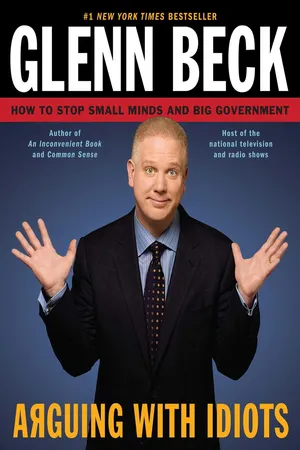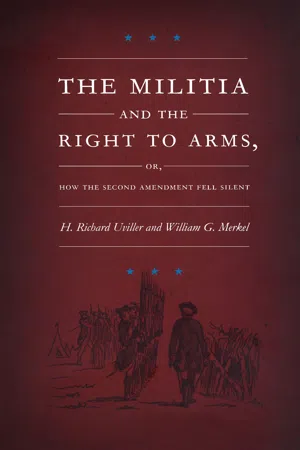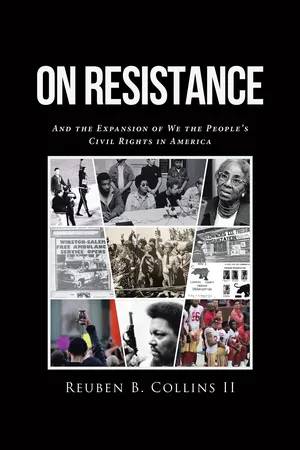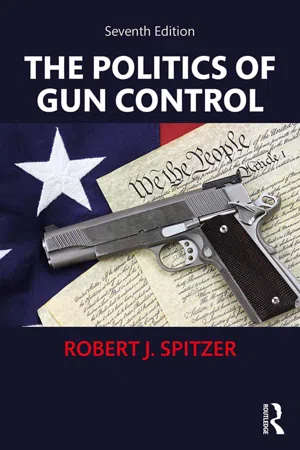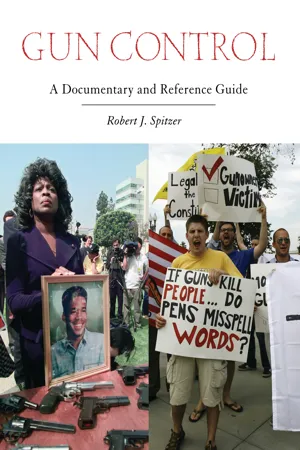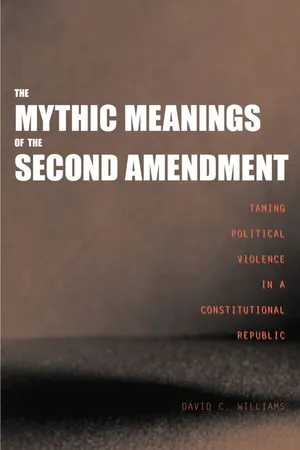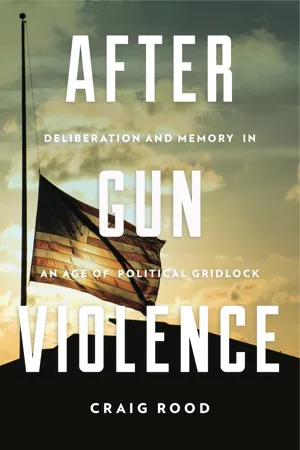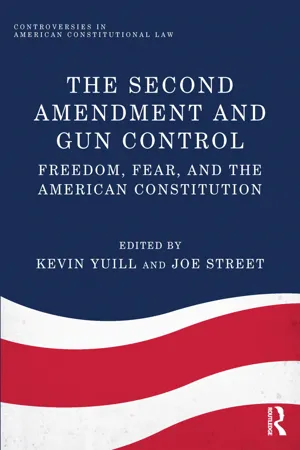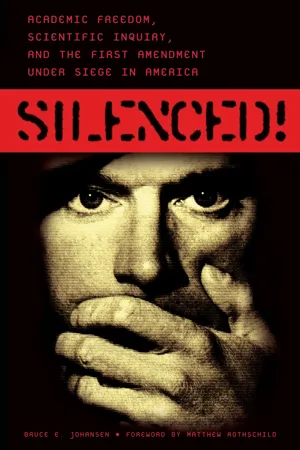Politics & International Relations
2nd Amendment
The 2nd Amendment to the United States Constitution protects the right of the people to keep and bear arms. It has been a subject of ongoing debate and controversy, with advocates arguing for the importance of individual gun ownership and opponents calling for stricter regulations to address public safety concerns. The interpretation and application of the 2nd Amendment continue to be significant issues in American politics.
Written by Perlego with AI-assistance
Related key terms
1 of 5
12 Key excerpts on "2nd Amendment"
- eBook - ePub
Arguing with Idiots
How to Stop Small Minds and Big Government
- Glenn Beck, Kevin Balfe(Authors)
- 2009(Publication Date)
- Threshold Editions(Publisher)
THE SECOND AMENDMENT
Ammunition to Defend Your Rights “A well regulated Militia, being necessary to the security of a free State, the right of the people to keep and bear Arms, shall not be infringed.”NOTHING illustrates the battle between the good forces of individual liberty and the destructive, idiotic forces of collectivism better than the ongoing battle over the meaning of those 27 little words.Normal people understand the natural existence of the right to bear arms, the plain language guaranteeing us that right, and the clearly documented history that led to its enshrinement in the Bill of Rights. But those who distrust individual freedoms in favor of an all-powerful government are horrified by the idea that one person can possess enough power to lawfully resist, with force, unacceptable intrusions into his or her life.Perhaps some of those opposed to the individual right to bear arms understand that, as King George once discovered, an armed populace is a populace that will not be pushed around. Perhaps they even understand Thomas Jefferson’s famous observation (or was it a warning?):“When governments fear the people, there is liberty. When the people fear the government, there is tyranny.”Whatever the reason, these people seem to appreciate, if not respect, the role of the Second Amendment in protecting our way of life. Successfully weaken it, and it’s only a matter of time before all of our other rights begin to fall away, like dominoes.That’s why so many of the debates over the Second Amendment aren’t really about guns at all; they’re about big versus small government, rights versus responsibilities, and, ultimately, about where the balance of power in America should reside: with politicians or with the people. That’s also why it’s so imperative that all Americans, gun lovers or not, understand their Second Amendment right well enough to fight for it against idiots who say things like . . . - eBook - ePub
The Ninth Amendment and the Politics of Creative Jurisprudence
Disparaging the Fundamental Right of Popular Control
- Marshall DeRosa(Author)
- 2017(Publication Date)
- Routledge(Publisher)
Thus, the fundamental laws of a majority of the states affirmed not merely the right of the citizens of the states to possess arms in the defense of themselves and their state, but also the necessity. This was a constitutional prerogative of the states and the Second Amendment to the U.S. Constitution essentially reaffirmed that prerogative. Moreover, without evidence to the contrary one must assume that the ratifying conventions of the states (which approved both the U.S. Constitution and the subsequent Bill of Rights) and the Congresses that admitted the various territories into the Union during this period were in the possession of rational men. Such being the case, it is obvious that the Second Amendment to the U.S. Constitution emanated from the determination of the U.S. Constitution’s drafters and ratifiers to provide the constitutional means whereby individuals and the states could protect their lives, liberties, and properties, not only through the political mechanisms of elections and separation of powers, but also through the right to resort to force when necessitated by circumstances, as stipulated in the organic laws of their states. Otherwise most of the states would have ratified a national constitution obtrusively inconsistent with a basic tenet of their own state constitutions.Publius’s acknowledgment of the states’ military superiority was not merely reassurance for the states who were concerned about national oppression, but a political imperative; he had no other politically viable alternative. The Second Amendment was the constitutional means to maintain this military imbalance of power between the two levels of government. This is not to imply that the U.S. Constitution is devoid of restrictions that limit a state from an impulsive recourse to arms, or that such a recourse was desirable. First, the entire scheme of federalism diverts political discontent through conflict resolution channels, such as the electoral process, the legislative process, judicial review, and the amendment process of Article V, all of which are designed to resolve conflict peaceably. Second, Article I, section 10, specifically prohibits states from keeping troops and ships of war in time of peace without the consent of the Congress. This limitation was designed to forestall the natural rivalry among the states themselves and between the states and the national government from degenerating into armed confrontation.24 Significantly, however, should the people of a state decide to exercise their natural right of revolution,25 - H. Richard Uviller, William G. Merkel, Neal Devins, Mark A. Graber, Neal Devins, Mark A. Graber(Authors)
- 2003(Publication Date)
- Duke University Press Books(Publisher)
Our historical approach is simply this: we take seri-ously the words chosen by the drafters, and seek their meaning to the ratifying generation. This approach discloses that to the Founders, and indeed to the entire literate polity of new-fledged Americans, the language of the Second Amendment could hardly have been a more felicitous expression of its scope, intent, and purpose. On this record, there seems to us little doubt that the provision protected as an individual right (and in more democratically generous form) the ancient English custom of free, adult citizens to keep and to carry arms, but only in the context and for the advancement of the orga-nized, occasional, communal, military units generally believed to be indispensable to the preservation of political liberty. 5 While recog-nizing this right, our new democracy firmly rejected the features of the progenitive English Bill of Rights of the seventeenth century that conditioned the right to ‘‘have arms’’ on ‘‘station’’ and loyalty to the Protestant faith. 6 Commentators writing from the individualist perspective gener-ally take a different view of the Second Amendment. Their read-ing does not necessarily reject history as a guide to the meaning of eighteenth-century documents. Indeed, many of the individualist writers go beyond the text and evolution of the constitutional pro-vision itself, and call upon a wider range of historical sources in-cluding the English Bill of Rights, Blackstone’s Commentaries on the Laws of England, and Justice Story’s Commentaries on the Constitution. But writers such as Joyce Lee Malcolm, Don B. Kates, Nelson Lund, and Stephen P. Halbrook typically misread the historical material they rely on, and consistently foist modern, libertarian concepts onto commu-nal Renaissance and Enlightenment constructs which they sever from their natural, historical contexts.- No longer available |Learn more
On Resistance
And the Expansion of We the People's Civil Rights in America
- Reuben B. Collins, Reuben B. Collins II(Authors)
- 2021(Publication Date)
- Page Publishing, Inc.(Publisher)
A color line was set during this period from the vantage point of state constitutions that appeared to be directly in contradiction of the US Constitution. Policy measures on the legislative level were put in place to ensure that the nation’s African population would be unarmed and unable to defend themselves from aggression triggered by the dominant white population. An additional consequence is possibly the proliferation of unregistered firearms in black households. This could be attributed to the fact that only within the last fifty to sixty years have the nation’s overall African American population been given the same right to purchase and register a firearm to protect his or home. Once again, state legislators couched themselves under the Tenth Amendment to justify racist policy. This renewed interpretation of gun possession under the guise of states’ rights conveniently allowed the individual states that made up the union to ensure that even freed men and women of African descent would be treated differently than the majority population in regard to the right to bear arms. For nearly two centuries, there was little disagreement from a national point of view on the actual meaning of the Second Amendment.This focus on state law ensured that the way the nation regulated gun ownership would be from a locally administered policy position as opposed to one that was federally dominated. Although the Second Amendment is cited as the primary authority that is followed when interpreting gun ownership and possession today, the actual regulations are based on state and local law. The Constitution does support the notion that gun regulation would be primarily administered on the state level. Article 1, Section 8 of the Constitution enumerates the powers vested in Congress which does not include the authority to regulate gun laws that are to be followed in all fifty states. Article 1 does, however, allow for the Congress to make all laws, which shall be necessary and proper and vested in the Constitution. Congress cannot create far-reaching national gun regulations; nevertheless, it is provided the authority to set forth policy that furthers national interest. Public safety is clearly a national interest.A limitation that exists as a result of this practice is the diversity of thought applied by all fifty state legislatures when addressing gun rights. Any consideration of gun legislation must first recognize the slippery slope that is in play when interpreting the Second Amendment and how any new potential legislation may impact individual gun rights. Restrictions on gun control ownership are not universal by any stretch in the United States of America. Logic would suggest that because of the lack of uniformity that is in place to govern how we regulate firearms, there would be a need for federal intervention. Because we lack uniformity, each state provides differing guidelines of what may be acceptable. Some states are much more restrictive than others. Reciprocity may be recognized in some states if, for example, you own a legally purchased firearm from state A. Not every state recognizes that right, however, so it is important to understand the laws of every state if you own a firearm. Although not an absolute distinction, it is generally the case that the nation’s more heavily populated states have the most restrictions on gun ownership. - eBook - ePub
- Robert J. Spitzer(Author)
- 2017(Publication Date)
- Routledge(Publisher)
1, pt. 1, 380–81. See also the definition of self-defense in Henry C. Black, Black’s Law Dictionary (St. Paul, MN: West, 1991), 947. 97 D.C. v. Heller, at 598, 600, and 613. The court was not declaring this to be a right under the Second Amendment; it was a passing comment referred to as “dictum.” 98 Robert E. Shalhope says the Second Amendment protects weapons possession for Americans in part “for the purpose of keeping their rulers sensitive to the rights of the people.” Would this make, say, Lee Harvey Oswald, John Wilkes Booth, and David Koresh true democrats? “The Ideological Origins of the Second Amendment,” Journal of American History 69 (December 1982): 614. See also Halbrook, That Every Man Be Armed, 68, 194–95; Lund, “The Second Amendment, Political Liberty, and the Right to Self-Preservation,” 111–16; Wayne LaPierre, Guns, Crime, and Freedom (Washington, DC: Regnery, 1994), 19–20; and Glenn H. Reynolds, “The Right to Keep and Bear Arms under the Tennessee Constitution,” Tennessee Law Review 61 (Winter 1994): 668–69. 99 Roscoe Pound, The Development of Constitutional Guarantees of Liberty (New Haven, CT: Yale University Press, 1957), 90–91. See also Wendy Brown, “Guns, Cowboys, Philadelphia Mayors, and Civic Republicanism: On Sanford Levinson’s ‘The Embarrassing Second Amendment,’” Yale Law Journal 99 (December 1989): 661–67. 100 Saul Cornell, Whose Right to Bear Arms Did the Second Amendment Protect? (Boston, MA: Bedford/St. Martin’s, 2000), 19–20. Stuart R. Hays goes so far as to cite with approval the Civil War as an instance of “the right to revolt when the laws of the government began to oppress.” Whatever one thinks of that conflict, the effort of Southern states to break away from the Union was not within the bounds of the Constitution but an attack on the document and was a threat to the Union’s continued existence - eBook - PDF
Gun Control
A Documentary and Reference Guide
- Robert J. Spitzer(Author)
- 2009(Publication Date)
- Greenwood(Publisher)
These include the absolute prohibition of handguns held and used for self-defense in the home. Undoubtedly some think that the Second Amendment is outmoded in a society where our standing army is the pride of our Nation, where well-trained police forces provide personal security, and where gun violence is a serious problem. That is perhaps debatable, but what is not debatable is that it is not the role of this Court to pronounce the Second Amendment extinct. We affirm the judgment of the Court of Appeals. It is so ordered. . . . Justice Stevens, with whom Justice Souter, Justice Ginsburg, and Justice Breyer join, dissenting. The question presented by this case is not whether the Second Amendment pro- tects a “collective right” or an “individual right.” Surely it protects a right that can be enforced by individuals. But a conclusion that the Second Amendment protects an individual right does not tell us anything about the scope of that right. Guns are used to hunt, for self-defense, to commit crimes, for sporting activities, and to perform military duties. The Second Amendment plainly does not protect the right to use a gun to rob a bank; it is equally clear that it does encompass the right to use weapons for certain military purposes. Whether it also protects the right to pos- sess and use guns for nonmilitary purposes like hunting and personal self-defense is the question presented by this case. The text of the Amendment, its history, and our decision in United States v. Miller, 307 U.S. 174 (1939), provide a clear answer to that question. The Second Amendment was adopted to protect the right of the people of each of the several States to maintain a well-regulated militia. It was a response to concerns raised during the ratification of the Constitution that the power of Congress to dis- arm the state militias and create a national standing army posed an intolerable threat to the sovereignty of the several States. - eBook - PDF
The Mythic Meanings of the Second Amendment
Taming Political Violence in a Constitutional Republic
- David C. Williams(Author)
- 2008(Publication Date)
- Yale University Press(Publisher)
69 3 The Original Legal Meaning of the Second Amendment and the Military Provisions of the Constitution The preceding two chapters examined the historical development of the Second Amendment and the military provisions of the Constitution, as back-ground for their original legal meaning. This chapter will offer a formulation of that meaning, to the extent that the record allows. Here, then, is the original legal meaning of the Second Amendment: To ensure that the Body of the People is prepared to resist a corrupt central government, the Body of the People shall have the right to keep and bear arms. Here is the original meaning of Article I: To ensure that the People in Congress Assembled may resist a corrupt insurrection, Congress shall have the power to maintain and deploy military forces against domestic unrest. Finally, here is the meaning of the two read together: The people have two modes of expressing their will about the use of political violence—representatively in Congress and directly in the mili-tia; either mode is subject to corruption, leading to tyranny on the one hand or insurrection on the other, and thus the Constitution empowers both so that they can check one another. Original intent is not all there is to constitutional interpretation, and even if it were, conditions often change so drastically that constitutional provisions simply cannot bear their original meaning any longer. Still, we cannot know where we are unless we begin with where we have been. Moreover, most modern discussion of the amendment gives central significance to its original 70 The Framers’ Constitution meaning; each side claims the Framers as devoted supporters of their view, as though Patrick Henry were a member of the NRA and James Madison a member of Handgun Control. Neither side can win this game because the amendment’s original meaning does not speak in the same categories as the modern debate. - eBook - PDF
After Gun Violence
Deliberation and Memory in an Age of Political Gridlock
- Craig Rood(Author)
- 2019(Publication Date)
- Penn State University Press(Publisher)
2 ThE wEighT of ThE pasT: mEmoRy and ThE sEcond amEndmEnT A well regulated Militia, being necessary to the security of a free State, the right of the people to keep and bear Arms, shall not be infringed. —sEcond amEndmEnT, bill of RighTs, 1791 Unlike the Ten Commandments, the Bill of Rights wasn’t cut into stone tablets. But the text surely has that same righteous feel to it. It’s as if you can sense the unseen hand of the Almighty God guiding the sweep of a goose quill pen, while some rebellious old white guys sweated out the birth of a nation. —chaRlTon hEsTon, JanuaRy 27, 1998 When Americans talk about gun policy, they regularly talk about the Second Amendment. Such was the case after the shooting at Sandy Hook Elemen- tary School on December 14, 2012. A month after the shooting, the White House proposed expanding background checks, banning assault weapons, and limiting magazine capacity to ten rounds. In making the case for these proposals, President Obama attempted to challenge the presumption that debates about gun policy should only be about the Second Amendment. He claimed that this right, while crucially important, should not be allowed to infringe on other rights, such as free speech and the right to life. He also claimed that rights must coexist with responsibilities (a claim that I describe further in chapter 3). But Obama also addressed the Second Amendment head on, declaring, “Like most Americans, I believe the Second Amend- ment guarantees an individual right to bear arms.” He continued, “I also believe most gun owners agree that we can respect the Second Amendment while keeping an irresponsible, law-breaking few from inflicting harm on a ThE wEighT of ThE pasT 49 massive scale.” 1 Meanwhile, Wayne LaPierre, executive vice president of the NRA, insisted that there could be no middle ground: any regulation, no mat- ter how large or small, undermined the Second Amendment. “I’ve got news for the president,” LaPierre declared. - eBook - PDF
Culture Wars in America
A Documentary and Reference Guide
- Glenn H. Utter(Author)
- 2009(Publication Date)
- Greenwood(Publisher)
officials and gun con- trol supporters in Heller—taken from the Kansas Supreme Court’s decision in Salina v. Blaksley (1905)—that the amendment protects only a privilege to possess arms when serving in a militia. All nine justices rejected gun control supporters’ alternate 151 and mutually exclusive idea—invented by the U.S. Court of Appeals for the 3rd Circuit in U.S. v. Tot (1942)—that the amendment protects only a state power (a so-called ‘‘collective right’’) to maintain a militia. Citing a previous decision by the court, recognizing that the right to arms is individually-held, the court noted, ‘‘As we said in United States v. Cruikshank (1876), ‘[t]his is not a right granted by the Constitution. Neither is it in any manner dependent upon that instrument for its existence. The Second Amendment declares that it shall not be infringed.’ ’’ The court also declared that the Second Amendment protects ‘‘the individual right to possess and carry weapons in case of confrontation,’’ including ‘‘all instru- ments that constitute bearable arms.’’ It said that people have the right to keep and bear handguns (the type of arm at issue in Heller), because ‘‘[T]he inherent right of self-defense has been central to the Second Amendment right. . . . Under any of the standards of scrutiny that we have applied to enumerated constitutional rights, banning from the home ‘the most preferred firearm in the nation to ‘keep’ and use for protection of one’s home and family,’ would fail constitutional muster.’’ As demonstrated by the vast majority of research on the subject, the court’s ruling is consistent with the Second Amendment’s history and text, the statements and writings of the amendment’s author, James Madison, and other statesmen of the founding period, and the writings of respected legal authorities of the 19th century. - eBook - ePub
The Second Amendment and Gun Control
Freedom, Fear, and the American Constitution
- Kevin Yuill, Joe Street, Kevin Yuill, Joe Street(Authors)
- 2017(Publication Date)
- Routledge(Publisher)
Guns and Violence: The English Experience (Cambridge, MA: Harvard University Press 2002), 155–156, 159–161, 171–172.3 Firearms Act, 1997, Firearms Act, no. 2, 1997.4 “Ask the Police” at www.askthe.police.uk/ .5 US Supreme Court, District of Columbia v. Heller (2008), US Supreme Court, McDonald v. City of Chicago (2010). The idea that the Second Amendment did not protect an individual right but was only a guarantee that states could have a militia was argued from the 1960s and became a common view in law schools. The question had never been decided by the Supreme Court. Both recent decisions found the core of the amendment is the right of individuals to have arms for personal defense.6 These “constitutional carry” states are Alaska, Arizona, Arkansas, Idaho, Kansas, Maine, Mississippi, Missouri, New Hampshire, Vermont, West Virginia, Wyoming. Several other states are considering changing to constitutional carry this year.7 These eight include California in the west and New York, Massachusetts, Rhode Island, Delaware, New Jersey, and Maryland on the east coast, and Hawaii. The number of shall-issue states has increased year by year, leaving only these eight as holdouts.8 www.thetruthaboutguns.com/2016/01/dean-weingarten/2015-record-year-for-firearms-sales-and-nics-background-checks/ .9 Blackstone, Commentaries , vol. 3, 3–4.10 John Locke, An Essay Concerning the True, Original, Extent, and End of Civil Government (1690), par. 11.11 - eBook - ePub
Gun Control and the Constitution
The Courts, Congress, and the Second Amendment
- Robert J. Cottrol(Author)
- 2023(Publication Date)
- Routledge(Publisher)
infra.63. See note 77 and accompanying text. Gardiner has suggested that the organization of the Constitution and Bill of Rights was deliberately modeled after Blackstone’s organization of the five legal precepts he considered fundamental to the maintenance of English liberty. See Gardiner, supra note 10, at 65 n.8. The correspondence can be established as follows: parliamentary powers and privileges are comprehended in art. I; the limitations on the powers of the monarch (executive branch) are comprehended in art. II; the institution and powers of the courts of justice are comprehended in art. Ill; the right to apply to Parliament for redress of grievances is comprehended in the first amendment; and the right to possess arms is covered in the second amendment. If meritorious, this analysis further buttresses the individual right position since Blackstone included the right to arms among the “absolute rights of individuals.” See note \53 infra.B. The Proposal and Ratification of the Second Amendment
As we have seen, the language of the second amendment supports the individual interpretation of the right to keep and bear arms. The nature of the controversy over ratification of the Constitution and the various proposals for and debate over the Bill of Rights also buttress the individual right view, for the one thing all the Framers agreed on was the desirability of allowing citizens to arm themselves. - eBook - PDF
Silenced!
Academic Freedom, Scientific Inquiry, and the First Amendment under Siege in America
- Bruce E. Johansen(Author)
- 2007(Publication Date)
- Praeger(Publisher)
Chapter 3 The Second Amendment Trumps the First AMERICAN ENGLISH BRIMS with metaphors of armament, many of which were applied to Michael Bellesiles, historian formerly of Emory University, as he shot it out with supporters of the right to bear arms, contending that their version of American history was a flint-loaded myth. Armed with massive indignation and fact-checking furor, independent scholars and the armaments-industrial complex shot back. With critics locked and loaded, Bellesiles’s book Arming America: The Origins of a National Gun Culture (Bellesiles, 2000) was picked apart, as his crit- ics laid down a rain of fire contending that, factually, he couldn’t shoot straight. Worse than that, they asserted that Bellesiles was shooting blanks. By stretching statistics to fit his predetermined conclusions, the critics charged, Bellesiles had fired from the hip and thereby shot himself in the foot—both feet, in fact. Friendly fire, this was not. Following a university inquiry that largely agreed with the critics, Bellesiles resigned his academic position at Emory, which earlier had sponsored his Institute on the Study of Violence in America. Bellesiles was also stripped of Columbia University’s prestigious Bancroft Prize, as one of his publishers canceled a con- tract. Quickly, proud gun owners, asserting that Bellesiles had been righteously cut off at the knees (or cut off at the pass), took aim at public-library holdings of Arming America, sniping it off shelves, suggesting, in their kinder moods, that the book should be moved to the fiction stacks. Bellesiles supporters, or people sporting merely a soft spot in their hearts for wide-open debate, contended that Bellesiles had been shot in the back, a victim of critics armed and dangerous, in a case of the Second Amendment trumping the First. Guns are serious business in the United States. The Second Amendment, originally enacted to prevent recolonization of the United States by the British
Index pages curate the most relevant extracts from our library of academic textbooks. They’ve been created using an in-house natural language model (NLM), each adding context and meaning to key research topics.
